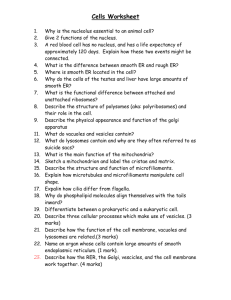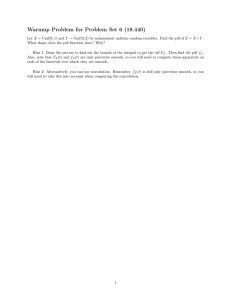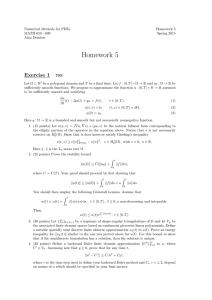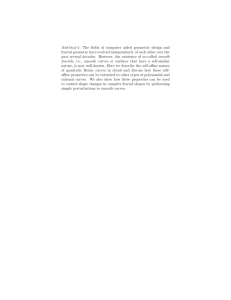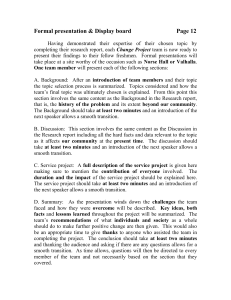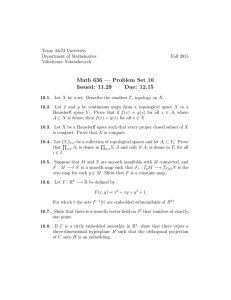Steps in Differential Geometry, Proceedings of the Colloquium
advertisement
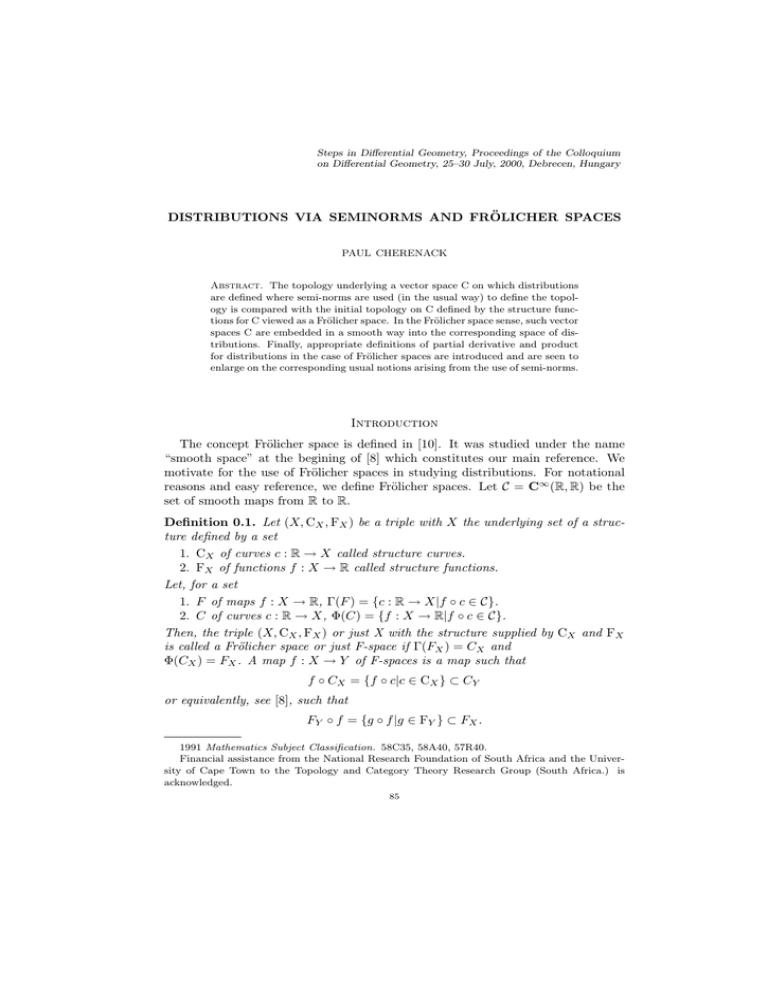
Steps in Differential Geometry, Proceedings of the Colloquium
on Differential Geometry, 25–30 July, 2000, Debrecen, Hungary
DISTRIBUTIONS VIA SEMINORMS AND FRÖLICHER SPACES
PAUL CHERENACK
Abstract. The topology underlying a vector space C on which distributions
are defined where semi-norms are used (in the usual way) to define the topology is compared with the initial topology on C defined by the structure functions for C viewed as a Frölicher space. In the Frölicher space sense, such vector
spaces C are embedded in a smooth way into the corresponding space of distributions. Finally, appropriate definitions of partial derivative and product
for distributions in the case of Frölicher spaces are introduced and are seen to
enlarge on the corresponding usual notions arising from the use of semi-norms.
Introduction
The concept Frölicher space is defined in [10]. It was studied under the name
“smooth space” at the begining of [8] which constitutes our main reference. We
motivate for the use of Frölicher spaces in studying distributions. For notational
reasons and easy reference, we define Frölicher spaces. Let C = C∞ (R, R) be the
set of smooth maps from R to R.
Definition 0.1. Let (X, CX , FX ) be a triple with X the underlying set of a structure defined by a set
1. CX of curves c : R → X called structure curves.
2. FX of functions f : X → R called structure functions.
Let, for a set
1. F of maps f : X → R, Γ(F ) = {c : R → X|f ◦ c ∈ C}.
2. C of curves c : R → X, Φ(C) = {f : X → R|f ◦ c ∈ C}.
Then, the triple (X, CX , FX ) or just X with the structure supplied by CX and FX
is called a Frölicher space or just F-space if Γ(FX ) = CX and
Φ(CX ) = FX . A map f : X → Y of F-spaces is a map such that
f ◦ CX = {f ◦ c|c ∈ CX } ⊂ CY
or equivalently, see [8], such that
FY ◦ f = {g ◦ f |g ∈ FY } ⊂ FX .
1991 Mathematics Subject Classification. 58C35, 58A40, 57R40.
Financial assistance from the National Research Foundation of South Africa and the University of Cape Town to the Topology and Category Theory Research Group (South Africa.) is
acknowledged.
85
86
PAUL CHERENACK
A map of F-spaces will be referred to as F-smooth or just smooth according to need.
Frölicher and Kriegl [8] show that the category FRL of Frölicher spaces has
initial and final structures and is thus complete and cocomplete. Let X1 and X2
be F-spaces with the same underlying set X. Let 1X : X1 → X2 denote the identity
map. If 1X is smooth, then X1 has a finer structure than X2 and X2 has a courser
structure than X1 . Then, as with topological spaces, for any collection of F-space
structures on a set X, there is a coursest structure on X finer than any of these
structures and there is a finest structure on X courser than any of these structures.
This enables one to define, as with topological spaces, initial and final structures.
However, as opposed to topological spaces, for F-spaces X and Y , there is a natural
([8])structure on
HOMF (X, Y ) = {f : X → Y |f is smooth }
obtained by setting
CHOMF (X,Y ) = {c : R → HOMF (X, Y )|ĉ : R × X → Y is smooth},
where ĉ(t, x) = c(t)(x) and one has FHOMF (X,Y ) = Φ(CHOMF (X,Y ) ). We will write
Y X to denote HOMF (X, Y ) with this structure. We prove in [3] the following
version of the Uniform Boundedness Principle (see [10]):
Theorem 0.1. Let X and Y be Frölicher spaces. Suppose that FY , the set of
structure functions on Y , separates points. The structure on Y X is initial structure
induced by the evaluation maps evx : HOMF (X, Y ) → Y (x ∈ X) where evx (f ) =
f (x).
We note that a smooth (C∞ ) manifold, with the usual notion of smooth curve
into it and smooth real valued function on it, is a F-space. This assertion uses
Boman’s Theorem [1] or [2]. We use the reference [6] or [12] for our reference to
ordinary distribution theory.
n
Let K be a compact subset of Rn . Let C(Rn ) = RR ,
Cc (Rn ) denote the set of all f ∈ C(Rn ) such that f has compact support and
Cc,K (Rn ) denote the set of all f ∈ C(Rn ) such that f has support in K. Let Y be
a F-space and iX : X → Y an inclusion set map. Then, X becomes a F-subspace
of Y on setting CX = {c : R → X|iX ◦ c ∈ CY }. Thus, Cc (Rn ) and Cc,K (Rn ) can
be viewed as F-subspaces of C(Rn ). We show:
Lemma 0.1. Alternatively, letting ĉ(t, x) = c(t)(x) and M ⊂ C(Rn ) have the Fsubspace structure, CM = {c : R → M |ĉ : R × Rn → R is smooth }. Here, M could
for instance, be Cc (Rn ) or Cc,K (Rn ).
Proof. Let d : R → M and dˆ be snooth. Then, id
◦ d, for the inclusion i : M →
ˆ x). Thus, i ◦ d is smooth and
C(Rn ), is smooth as id
◦ d(t, x) = i ◦ d(t)(x) = d(t,
hence d ∈ CM . The sequence of implications used is readily reversed.
The paper will be presented in the following manner:
DISTRIBUTIONS VIA SEMINORMS AND FRÖLICHER SPACES
87
Section 1: F-distributions: Here we introduce the notion of F-distribution
using a series of results to place this theory in perspective.
Section 2: F and ordinary distributions: Here we show that, for K a closed
interval, the norm | · |K on a F-subspace MMCc,K (R) of Cc,K (Rn ) consisting
of Morse functions with a unique maximum and minimum in the interior of
K, is smooth. Thus, as far as | · |K is concerned, the topology on the Fspace MMCc,K (R) is finer than the topology which it posseses in ordinary
distribution theory.
Section 3: Embeddings: We show that there is a F-space embedding of the
collection Cc (R) of smooth functions on R with compact support into the
space of F-distributions.
Section 4: Operations on F-distributions: We calculate the derivative of
F-distributions and partial derivatives of F-distributions. Convolution for
F-distributions is seen to be a smooth operation.
1. Section: F-distributions
To distinguish ordinary distribution theory from that occuring with respect to
F-spaces we refer, for instance, to F-distribution theory. We endow a F-space X
with the initial topology given by the functions f : X → R, f ∈ FX .This topology
has as a basis open sets of the form f −1 (0, 1), f ∈ FX . For smooth manifolds one
obtains the usual topology.
Let Cc (Rn ) be a F-space with the same underlying set as Cc (Rn ) but with a set
of structure curves C = Γ ◦ Φ(C0 ) where d ∈ C0 if and only if d is a smooth curve
d : R → Cc (Rn ) and, for each a ∈ R, there is an > 0 such that d(t) has support in
some compact set K ∗ for each t ∈ (a − , a + ). We say that C0 generates C (see
[8]). The set of structure functions on Cc (Rn ) is given by F = Φ(C0 ). The smooth
1
ˆ given by d(t)
ˆ = e− t2 (1−(t2 x2 )) for tx < 1, t > 0 and 0 otherwise, defines a
map d,
smooth curve into Cc (Rn ) which is not in C0 . As C0 ⊂ Cc (Rn ), the structure
on Cc (Rn ) is finer than the structure of Cc (Rn ). We expect that the structure of
Cc (Rn ) will not be the same as the structure of Cc (Rn ). In ordinary distribution
theory, one has, by definition, the following result.
Theorem 1.1. Let K denote the collection of compact subsets of a F-space X
ordered by inclusion. Taking an inductive limit over K, one obtains in the category
of F-spaces
Cc (Rn ) = lim Cc,K (Rn ).
K∈K
Proof. One need only show that the final structure on the underlying set
[
Cc (Rn ) =
Cc,K (Rn ) = lim Cc,K (Rn ),
K∈K
K∈K
for the inclusions iK : Cc,K (Rn ) → Cc (Rn ), agrees with the given structure on
Cc (Rn ). Since the inclusions iK are smooth when viewed as maps iK : Cc,K (Rn ) →
Cc (Rn ), the definition of direct limits implies that the identity map
88
PAUL CHERENACK
limK∈K Cc,K (Rn ) → Cc (Rn ) is smooth. Now, for d ∈ C0 , let d(b) = g. Suppose that g has support K. There is a compact set K ∗ containing K such that, for
some > 0, d(t) has compact support in K ∗ for t ∈ (b−, b+). This implies that d
is a smooth curve into Cc,K ∗ (Rn ) and hence limK∈K Cc,K (Rn ) for t ∈ (b − , b + ).
Since b is arbitrary, d(t) is smooth. Since C0 generates C, we are done (see [8]).
Thus, in some ways, Cc (Rn ) is a better candidate than Cc (Rn ) for the F-space
on which F-distributions will be defined.
One also can show:
Lemma 1.1. For F-space topologies, Cc,K (Rn ) is a closed subset of Cc (Rn ) and
Cc (Rn ).
Proof. Let g ∈ Cc (Rn ) − Cc,K (Rn ) = D. There is a x ∈
/ K such that evx (g) =
g(x) 6= 0. Thus, g ∈ evx−1 (R − {0}) ⊂ D. Since Cc (Rn ) has more structure
functions than Cc (Rn ), it has a finer topology than Cc (Rn ).
We would like to prove or find a counter example to the following:
Conjecture 1. Suppose that Cc,K (Rn ) has its F-space topology. If
limK∈K Cc,K (Rn ) is taken in topological spaces, then the resulting topology is the
same as the F-space topology of Cc (Rn ).
Of course one would like to show that Cc (Rn ) with its F-space topology, as for
ordinary distributions, is sequentially compact. One can show that every Cauchy
sequence in Cc (R) and the corresponding sequences of derivatives converge pointwise. But this is only a begining.
It is easy to define F-distributions:
Definition 1.1. A F-distribution D on Rn is a smooth map D : Cc (Rn ) → R,
i.e., a map such that D ◦ d is smooth for each smooth curve d : R → Cc (Rn ) and d
ˆ x) = d(s)(x) is
is smooth if the corresponding map dˆ : R × Rn → R defined by d(s,
smooth in the usual sense. A linear F-distribution (linearity is normal for ordinary
n
distributions) is a F-distribution that is a linear map. Let Dn = RCc (R ) denote
the F-space of F-distributions on Rn .
Clearly, this definition can be extended to distributions on arbitrary F-spaces.
Examples:
1. The evaluation maps evx , which are also the Dirac delta functions, defining
the F-space structure on Cc (Rn ).
2. The maps D : Cc (Rn ) → R sending g to a partial derivative
∂g
x0 ), j = 1,R· · · , n and ~x0 a fixed point.
∂xj (~
3. Let I(h)(g) = Rn h(~x)g(~x)dV where h ∈ Cc (Rn ). Then, I(h) is a
F-distribution.
4. If I1 , · · · , In are F-distributions and g ∈ C(Rn ), then g(I1 , · · · , In ) is a
F-distribution. This contrasts markedly with the situation ordinarily
assumed for distributions.
DISTRIBUTIONS VIA SEMINORMS AND FRÖLICHER SPACES
89
2. Section: F versa ordinary distributions
For simplicity and since this suffices, we assume in this section that our compact
subsets K of R are bounded closed intervals. By definition a function f : R → R
with support K is a Morse function on the compact set K if and only if it is a
Morse function on the interior of K (see [11] for this last notion). Let MMCc,K (R)
denote the subset of Cc,K (R) consisting of Morse functions having a maximum at
a unique point and minimum at a unique point. Note that 0 6∈ MMCc,K (R). The
open subsets of Cc,K (R) in (ordinary) distribution theory are in part defined by
the semi-norm | · |K where |g|K = supx∈K |g(x)|.
Lemma 2.1. The set {x ∈ MMCc,K (R)||x|K < } is open in the F-space topology
on the subspace MMCc,K (R) of Cc,K (R).
Proof. Let d : R → MMCc,K (R) be a smooth curve and d(a) = g. Suppose that
ˆ x) = d(t)(x). We show that the assignment α : t ,→ sup
ˆ
d(t,
x∈K d(t, x) is smooth.
Since d has an image in MMCc,K (R),
ˆ x) = d(t)(at ) with at unique for each t ∈ R and d(t)(at ) 6= 0. Since d(t)
supx∈K d(t,
is a Morse function for each t ∈ R, d(t)00 (at ) 6= 0, t ∈ R. It follows that d(t)0 (x) = 0
can be solved for x = at , a smooth function in t. Thus, α(t) = d(t)(at ) is a smooth
function in t. Thus, the assignment g → supx∈K g defines a smooth real valued
map on MMCc,K (R). Similarly, the assignment g → inf x∈K g defines a smooth
real valued map on MMCc,K (R). Finally, note that |g|K < is equivalent to
supx∈K g < and − < inf x∈K g.
It is reasonably clear that the last result extends from R to Rn . Also, one expects
that, in the Whitney strong topology, MMCc,K (R) is an open dense subset of
Cc,K (R).
Let FMCc,K (R) denote the subset of the set MCc,K (R) of Morse functions
with support K consisting of functions h (see [11]) which are Morse functions on
K; thus, if h0 (b) = 0 for b in the interior of K, then h00 (b) 6= 0. We prove an
analogous version of Lemma 2.1. First, we need:
Lemma 2.2. Let k ∈ MMCc,K (R) have a unique maximum at b and let d : R →
MCc,K (R) be a smooth curve with d(a) = k. Then for t in a neighborhood of a,
d(t) has a maximum at a unique point.
ˆ s) = d(t)(s). As
Proof. Consider the smooth map dˆ : R × R → R with d(t,
∂ 2 dˆ
∂ 2 dˆ
00
00
00
∂s2 (a, b) = d(a) (b) = k (b) < 0, d(t) (s) = ∂s2 (t, s) < 0 for a − δ1 ≤ t ≤
a + δ1 , b − ρ1 ≤ s ≤ b + ρ1 for suitable δ1 , ρ1 > 0. Thus, d(t) is concave
downward if a − δ1 ≤ t ≤ a + δ1 in the interval b − ρ1 ≤ s ≤ b + ρ1 with
ˆ b). Using the fact that k is lob − ρ1 , b + ρ1 ∈ K. Let M = k(b) = d(a,
cally increasing to the left of b and decreasing to the right of b, there is a value
b − δ1 < s1 < b and a value b + δ1 > s2 > b such that m1 = k(s1 ) ≥ k(s) for
s ≤ s1 and k(s2 ) ≥ k(s) for s ≥ s2 . Let q = min{(M −m81 ),(M −m2 )} . Using the
ˆ t) > M − q if
continuity of dˆ there are 0 < δ2 < δ1 , 0 < ρ2 < ρ1 such that d(s,
90
PAUL CHERENACK
a − δ2 ≤ t ≤ a + δ2 , b − ρ2 ≤ s ≤ b + ρ2 . Using the compactness of K − K ∩ (s1 , s2 ),
ˆ t) < M − q if a − δ3 < t < a + δ3 and
one can find 0 < δ3 < δ2 , γ > 0 such that d(s,
either s ≥ s2 + γ or s ≤ s1 − γ but with s2 + γ < b + ρ1 and s1 − γ > b − ρ1 . From
construction, it follows that if a − δ3 ≤ t ≤ a + δ3 , then d(t)(s) has a maximum
and then a unique maximum which lies in the interval (b − ρ1 , b + ρ1 ), because of
concavity.
Lemma 2.3. Let > 0 and BUP() = {g ∈ FMCc,K (R)|supx∈K g(x) < }.
Let FMC(n) be the set of all h ∈ FMCc,K (R) such that h has local maxima at
exactly n different points in the interior of K. Then, FMCc,K (R) is the coproduct
of the F-subspaces FMC(n). For any real number there are smooth maps Hi :
FMCc,K (R) → R, i = 1, · · · , n, such that
\
BUP() ∩ FMC(n) =
(Hi−1 (−∞, ) ∩ FMC(n)).
i=1,··· ,n
Proof. Consider an element g ∈ FMCc,K (R) which has local maxima except at
the endpoints of K (finite in number as K is compact and g is a Morse function)
at x = b1 < · · · < bn . Let d : R → FMCc,K (R) be a smooth curve and d(a) = g.
Localizing to a neighborhood of each bi and, applying the technique of Lemma 2.1,
which is possible because of Lemma 2.2 applied locally, one obtains smooth curves
xi (t) = ait defined on an open interval I with xi (a) = bi and such that d(t)(x), for
fixed t, has local maxima at xi (t). The curves xi (t), i = 1, · · · , n never meet for
t ∈ I since there is always a point of inflection between them. Since d(t)0 (xi (t)) = 0
for t ∈ I, d(t)0 (xi (t)) = 0 at the endpoints of I. Since d maps into FMCc,K (R),
d(t)00 (xi (t)) < 0 at the endpoints of I. Thus, one can continue the xi (t) until
I = R. Clearly, every local maximum of every curve d(t), t ∈ R, lies on some curve
xi (t), i = 1, · · · , n. Since each curve d(t) has its image in exactly one FMC(n), it
follows that FMCc,K (R) is the coproduct of the F-subspaces FMC(n).
For an arbitrary element k ∈ FMCc,K (R) which has local maxima at x =
d1 < · · · < dn , define Hi (k) = k(di ). For i > n, define Hi (k) = 0. Then, as
Hi (d(t)) = d(t)(xi (t)), Hi (d(t)) is smooth. Since d(t) is arbitrary, Hi is smooth.
Let T
g ∈ BUP() ∩ FMC(n). Then, Hi (g) = g(di ) < for i = 1, · · · , n and hence
g ∈ i=1,··· ,n (Hi−1 (−∞, ) ∩ FMC(n)). Since the reverse implication clearly holds,
we are done.
From the above result one readily obtains:
Theorem 2.1. The set {g ∈ FMCc,K (R)||g|K < } is open for the F-space structure on FMCc,K (R).
Remark: It seems likely that the topology of the F-space structure on Cc (R)
is finer than the usual topology. The other direction requires some better understanding of the smooth scalars on Cc (R), i.e., the F-distributions. We note (see
[11]) that the set of Morse functions on the interior K ◦ of K is open and dense in
◦
C(K ◦ ) = RK .
DISTRIBUTIONS VIA SEMINORMS AND FRÖLICHER SPACES
91
3. Embeddings
Let ι : Rn → C(Rn ) be a one-one map defined by setting ι(x1 , · · · , xn ) =
x1 y1 + · · · + xn yn , a linear polynomial in (y1 , · · · , yn ). We show:
Proposition 3.1. The map ι is an embedding identifying Rn with the F-subspace
ι(Rn ) of C(Rn ).
Proof. Since the assignment ((x1 , · · · , xn ), (y1 , · · · , yn )) → x1 y1 + · · · + xn yn is
smooth, the Cartesian closedness of FRL implies that ι is smooth. Let d : R →
ι(Rn ) be a smooth map. One has d(t)(y1 , · · · , yn ) = a1 (t)y1 + · · · + an (t)yn since
ˆ (y1 , · · · , yn )) is smooth in t. It
d(t) ∈ ι(Rn ) for each t. But, d(t)(y1 , · · · , yn ) = d(t,
−1
follows that ι (d(t)) = (a1 (t), · · · , an (t)) is smooth. Hence ι−1 : ι(Rn ) → Rn is
smooth and we are done.
We prove the result in Proposition 3.1 for Cc (Rn ) instead of Rn .
Proposition 3.2. The non-degenerate inner product
h , i : Cc (Rn ) × Cc (Rn ) → R
R
defined by setting hf, gi = Rn f gdx1 · · · dxn induces a smooth embedding I of
Cc (Rn ) into the set Dn of F-distributions on Rn .
Proof. Let n = 1. The inner product h , i is smooth since, for each smooth curve
d : R → Cc (R) × Cc (R) with d(t) = (d1 (t), d2 (t)), the assignment
Z
t→
d1 (t)d2 (t)dx
R
is a smooth function of t (see below). The map I satisfies I(g)(f ) = hf, gi. The
Cartesian closedness of FRL implies that I is smooth.
To show that I is an embedding, let
R d : R → I(Cc (R)) be a smooth map. Using
the fact that I is one-one, d(t)(f ) = R gt (x)f dx for some unique gt ∈ Cc (R). But,
gt (x) = ĝ(t, x). Thus, to show that the map t → gt is smooth in t, we need to know
that if
Z
(1)
V (t, ω) =
ĝ(t, x)fˆ(ω, x)dx
R
is smooth in t and ω for all smooth functions fˆ : R × R → R, then ĝ is smooth. In
1 iωx
e
and one obtains a smooth function
equation (1) we let fˆ(ω, x) = 2π
Z
1
(2)
F (t, ω) =
ĝ(t, x)eiωx dx
2π R
where, for each t, F (t, ω) is the Fourier transform of ĝ(t, x). See [9]. Applying the
inverse Fourier transform, one obtains the equation
Z
(3)
ĝ(t, x) =
F (t, ω)e−iωx dω
R
92
PAUL CHERENACK
Using results (8.11.1) and (8.11.2) in Dieudonne [7], which in particular allow us
to take derivatives under the integral sign, we are done.
For n > 1, one needs to show that, corresponding to equation (1) for n =
1 and using Boman’s Theorem, that V (t, (ω1 , · · · , ωn )) is smooth if and only if
f ((ω1 , · · · , ωn ), x) is smooth. Finally, on applying multi-dimensional Fourier and
inverse Fourier transforms together with (8.11.1) and (8.11.2) in [7], the proof is
complete.
4. Operations on F-distributions
4.1. Derivatives. Using the Cartesian closedness of FRL, one readily shows:
Proposition 4.1. Let Di denote the i-th partial of a function of n variables and
D = D1m1 · · · Dnmn . Then the map D : Cc (Rn ) → Cc (Rn ) is smooth.
This result doesn’t hold for differential
R spaces. See [3].
One has the relation I(h)(D(g)) = R hD(g)dx1 · · · dxn and, integrating repeatedly
by parts, the last quantity equals
R
m1 +···+mn
(−1)
gD(h)dx1 · · · dxn . Hence, we have:
Rn
Proposition 4.2. Viewing functions via their embedding I, one can define the
partial D of the F-distribution I(h) by setting
D(I(h))(g) = I(D(h))(g) = (−1)m1 +···+mn I(h)(D(g)).
We will define the derivative of F-distributions via the chain rule (which we
assume to hold). Let d : R → Cc (Rn ) be a smooth curve with d(0) = g, h =
ˆ
ˆ x) = d(t)(x). If the chain rule holds, then one
d0 (0) = ∂∂td |t=0 and, as usual, d(t,
expects that
(4)
J 0 (g)(h) = (J ◦ d)0 (0).
n
For a smooth map F : Rn → R, one can view the map F 0 as a map F 0 : Rn → RR .
n
Similarly, J 0 is a map J 0 : Cc (Rn ) → RCc (R ) and, given that (J ◦ d)0 (0) can be
calculated, J 0 is defined by (4). In [6], the product • of an element g ∈ Cc (Rn ) and
a distribution T is defined by setting g • T (h) = T (gh).
Examples:
R
1. Let T2 (k)(f ) = R kf 2 dx. Then, if k ∈ Cc (R), T2 (k) is a F-distribution on R.
Using the conventions
above, one has R
R
(T2 (k))0 (g)(h) = R k · 2d(0)d0 (0)dx = R k · 2ghdx. Thus,
(T2 (k))0 (g) = I(2gk) = 2g • I(k). The F-distribution T2 is defined by inner
squaring and this example is clearly extendable to higher dimension.
R
2. Using outer squaring, define
the F-distribution
T2 (k) by T2 (k) = ( R kf dx)2 .
R
R
Then, (T2 (k))0 (g)(h) = 2 R kgdx · R khdx = I(k)(h)I(k)(g). Thus, (T2 (k))0
is the map sending g → 2I(k)(g) · I(k)(−).
With our definition of derivative, one can prove the product rule:
DISTRIBUTIONS VIA SEMINORMS AND FRÖLICHER SPACES
93
Proposition 4.3. For F-distributions T1 and T2 on R, one has
(T1 T2 )0 = T1 T20 + T10 T2 : Cc (R) → R.
Proof. On the one hand, using the notation above, (T1 T2 )0 (g)(h) = ((T1 T2 ) ◦
d)0 (t) = ((T1 ◦ d)(T2 ◦ d))0 (t) = (T1 ◦ d)(0)(T2 (t) ◦ d)0 (0) + (T1 (t) ◦ d)0 (0)(T2 ◦ d)(0) =
T1 (g)(T2 )0 (g)(h) + (T1 )0 (g)(h)T2 (g). On the other hand, (T1 T20 + T10 T2 )(g)(h) =
(T1 (g)T20 (g)+T10 (g)T2 (g))(h) = T1 (g)T20 (g)(h)+T10 (g)T2 (g)(h) and we are done.
In the same way, one can show the quotient rule.
Using the embedding ι defined in Section 3, one might reasonably define, for a
∂T
F-distribution T on Rn , the j-th partial at 0̂ ∈ Cc (Rn ) via the equality ∂x
(0̂) =
j
0
n
(T ◦ d) (0) where d(t) is the smooth curve d : R → Cc (R ) satisfying d(t) = txj .
This definition makes sense if T extends to C(Rn ).
Example: For the F-distribution I(k) on Rn defined above, with k having comd(I(k)(txj ))
pact support, the definition of partial derivative makes sense and
=
dt
R
R dtxj
k
dx
·
·
·
dx
=
kx
dx
·
·
·
dx
=
(x
•
I(k))(1)
=
1
n
j
1
n
j
dt
R
R
∂k
− I( ∂x
)(1).
j
4.2. Operations. Consider the map (looked at above)
• : Cc (Rn ) × Dn → Dn
defined by sending (f, T ) to f • T where f • T (h) = T (f h).
Lemma 4.1. The map • is smooth.
Proof. Using the Cartesian closedness of FRL, one must show that if Tt is a smooth
family of F-distributions and ft is a smooth family in Cc (Rn ), then, for each g ∈
Cc (Rn ), the map t → Tt (ft g) is smooth. This is the case as multiplication of
smooth functions and evaluation in FRL, since FRL is Cartesian closed, are smooth
operations.
Since one can differentiate under the integral sign, one can show:
Lemma 4.2. Convolution acting on Cc (Rn ) is a smooth operation.
Let now T1 be a F-distribution on Rn and T2 be a F-distribution on Rm .
One defines the direct product T1 × T2 (see [12]) of T1 and T2 by setting, for
g ∈ Cc (Rn+m ), T1 × T2 (g) = T1 (h) where h(x1 , · · · , xn ) = T2 (g(x1 ,··· ,xn ) ) and
g(x1 ,··· ,xn ) (y1 , · · · , ym ) = g(x1 , · · · , xn , y1 , · · · , ym ). Note that since g has compact support, so does g(x1 ,··· ,xn ) . For this definition to make sense, one needs
to see that h is smooth. Thus, if (xt1 , · · · , xtn ) is a smooth family of points in
Rn , one needs to see that k(t) = T2 (g(xt1 ,··· ,xtn ) ) where g(xt1 ,··· ,xtn ) (y1 , · · · , ym ) =
g(xt1 , · · · , xtn , y1 , · · · , ym ), is a smooth function of t. But, k(t) is smooth since evaluation is a smooth map (from the Cartesian closedness of FRL), the map sending
t to g(xt1 ,··· ,xtn ) is smooth and the composite of smooth maps is smooth. See [12].
We define the notion of convolution for distributions:
94
PAUL CHERENACK
Definition 4.1. Let T1 and T2 be two distributions on Rn with compact support
(see [12]) and φ ∈ Cc (Rn ). Then,
T1 ∗ T2 (φ) = T1 × T2 (h̄)
where h̄ = φ((x1 , · · · , xn ) + (y1 , · · · , yn ))).
Let Dn,c be the collection of F-distributions on Rn with compact support. Finally, we show, as one would want:
Proposition 4.4. Convolution ∗ : Dn,c × Dn,c → Dn,c is a smooth operation.
Proof. One needs to show that if one has F-distributions with compact support
T1 (t), T2 (t) smooth in t, then the map
t → T1 (t)(T2 (t)(φ(~x + ~y ))
n
for φ ∈ Cc (R ) is a smooth function of t. Since evaluation is a smooth map in
FRL, one need only show that the map
w : t → T2 (t)(φ(~x + ~y )) ∈ Cc (Rn )
is smooth. But w is smooth if the map ŵ : R×Rn → R, where ŵ(t, ~x) = T2 (t)(φ(~x +
~y )), is smooth. One has however ŵ(t, ~x) = ev ◦ (T2 × φ̄)(t, ~x) where ev is evaluation
and φ̄(t, ~x)(~y ) = φ(~x + ~y ) is clearly smooth in t, ~x and ~y . It follows that T2 and φ̄
are both smooth in t and ~x. Since evaluation is a smooth map, ŵ is smooth and
we are done.
References
[1] H. L. Bentley and P. Cherenack, Boman’s Theorem: strengthened and applied, to appear.
[2] J. Boman, Differentiability of a Function and of its Compositions with Functions of One
Variable, Math. Scand. 20(1967),249-268.
[3] P. Cherenack and P. Multarzyński, Smooth exponential objects and smooth distributions, to
appear.
[4] P. Cherenack. Applications of Frölicher spaces to cosmology, Annales Univ. Sci. Budapest41(1998)63-91.
[5] P. Cherenack. Fröhlicher versus Differential spaces: A Prelude to Cosmology, Applied Categorical Systems8/1-2(2000), 391-413.
[6] Y. Choquet-Bruhat and C. DeWitt-Morette, Analysis, Manifolds and Physics. (NorthHolland, Amsterdam, 1982).
[7] J.Dieudonné, Foundations of Modern Analysis. (Academic Press, New York, 1960).
[8] A. Frölicher and A. Kriegl, Linear Spaces and Differentiation Theory (Wiley-Interscience,
New York, 1971).
[9] R. Haberman, Elementay Applied Partial Differential Equations: with Fourier series and
Boundary Value Problems. (Prentice Hall, Upper Saddle River,N.J., 1998).
[10] A. Kriegl and P. Michor. The Convenient Setting of Global Analysis. (AMS, Providence,
1997).
[11] M. Hirsch, Differential Topology (Springer-Verlag, Berlin, 1976).
[12] A. H. Zemanian, Distribution Theory and Transform Analysis (Dover, New York, 1965).
Department of Mathematics and Applied Mathematics, University of Cape Town,
7700 Rondebosch, South Africa
